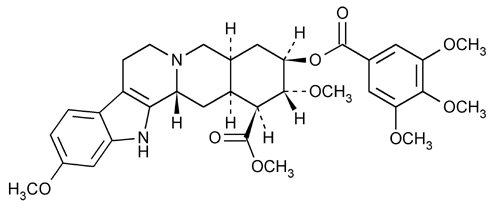Reserpine
Yohimban-16-carboxylic acid, 11,17-dimethoxy-18-[(3,4,5-trimethoxybenzoyl)oxy]-, methyl ester, (3
Methyl 18
» Reserpine contains not less than 97.0 percent and not more than 101.0 percent of C33H40N2O9, calculated on the dried basis.
Packaging and storage—
Preserve in tight, light-resistant containers. Store at 25 , excursions permitted between 15
, excursions permitted between 15 and 30
and 30 .
.
Identification—
B:
[note—Conduct this test promptly, with a minimum exposure to light.] Dissolve 25.0 mg of it, previously dried, in 0.25 mL of chloroform; mix with about 30 mL of methanol previously warmed to 50 ; transfer the mixture with the aid of warm methanol to a 250-mL volumetric flask; cool the solution to room temperature; dilute with methanol to volume; and mix. Pipet 10 mL of this solution into a 50-mL volumetric flask, add 36 mL of chloroform, dilute with methanol to volume, and mix: the UV absorption spectrum of a 1 in 50,000 solution so obtained exhibits the same maxima in the range of 255 nm to 350 nm as that of a similar solution of USP Reserpine RS, concomitantly measured; and the respective absorptivities, determined with reference to a mixture of 36 volumes of chloroform and 14 volumes of methanol as the blank, at the wavelength of maximum absorbance at about 268 nm, do not differ by more than 3.0%.
; transfer the mixture with the aid of warm methanol to a 250-mL volumetric flask; cool the solution to room temperature; dilute with methanol to volume; and mix. Pipet 10 mL of this solution into a 50-mL volumetric flask, add 36 mL of chloroform, dilute with methanol to volume, and mix: the UV absorption spectrum of a 1 in 50,000 solution so obtained exhibits the same maxima in the range of 255 nm to 350 nm as that of a similar solution of USP Reserpine RS, concomitantly measured; and the respective absorptivities, determined with reference to a mixture of 36 volumes of chloroform and 14 volumes of methanol as the blank, at the wavelength of maximum absorbance at about 268 nm, do not differ by more than 3.0%.
Loss on drying  731
731 —
Dry it at 60
—
Dry it at 60 for 3 hours: it loses not more than 0.5% of its weight.
for 3 hours: it loses not more than 0.5% of its weight.
Residue on ignition  281
281 :
not more than 0.1%.
:
not more than 0.1%.
Assay—
Mobile phase—
Prepare a filtered and degassed 1:1 mixture of acetonitrile and ammonium chloride solution (1 in 100). Make adjustments if necessary (see System Suitability under Chromatography  621
621 ). The pH is about 5.6.
). The pH is about 5.6.
Standard preparation—
Dissolve an accurately weighed quantity of USP Reserpine RS in Mobile phase, and dilute quantitatively, and stepwise if necessary, with Mobile phase to obtain a solution having a known concentration of about 10 µg per mL.
Assay preparation—
Transfer about 10 mg of Reserpine, accurately weighed, to a 100-mL volumetric flask. Dilute with Mobile phase to volume, and mix. Dilute 1.0 mL of this solution with 9.0 mL of Mobile phase, and mix.
Chromatographic system (see Chromatography  621
621 )—
The liquid chromatograph is equipped with a 268-nm detector and a 4.6-mm × 25-cm column that contains packing L1. The flow rate is about 1.5 mL per minute. Chromatograph the Standard preparation, and record the peak responses as directed for Procedure: the column efficiency determined from the analyte peak is not less than 1500 theoretical plates; the tailing factor for the analyte peak is not more than 1.5; and the relative standard deviation for replicate injections is not more than 2.0%.
)—
The liquid chromatograph is equipped with a 268-nm detector and a 4.6-mm × 25-cm column that contains packing L1. The flow rate is about 1.5 mL per minute. Chromatograph the Standard preparation, and record the peak responses as directed for Procedure: the column efficiency determined from the analyte peak is not less than 1500 theoretical plates; the tailing factor for the analyte peak is not more than 1.5; and the relative standard deviation for replicate injections is not more than 2.0%.
Procedure—
Separately inject equal volumes (about 20 µL) of the Standard preparation and the Assay preparation into the chromatograph, record the chromatograms, and measure the responses for the major peaks. Calculate the quantity, in mg, of C33H40N2O9 in the portion of Reserpine taken by the formula:
C(rU / rS)
in which C is the concentration, in µg per mL, of USP Reserpine RS in the Standard preparation; and rU and rS are the peak responses obtained from the Assay preparation and the Standard preparation, respectively.
Auxiliary Information—
Please check for your question in the FAQs before contacting USP.
Chromatographic Column—
| Topic/Question | Contact | Expert Committee |
| Monograph | Sujatha Ramakrishna, Ph.D.
Scientist 1-301-816-8349 |
(MDCV05) Monograph Development-Cardiovascular |
| Reference Standards | Lili Wang, Technical Services Scientist 1-301-816-8129 RSTech@usp.org |
USP32–NF27 Page 3486
Pharmacopeial Forum: Volume No. 29(5) Page 1570
Chromatographic columns text is not derived from, and not part of, USP 32 or NF 27.
